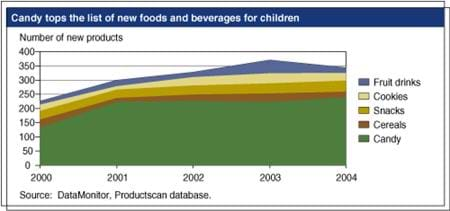Companies Continue To Offer New Foods Targeted to Children

Food manufacturers have been responding to increased concerns about childhood obesity rates and the marketing of high-fat, sugary foods to America’s children by developing new, more healthful foods and beverages. Between 2000 and 2004, the number of new whole-grain, low-fat, and low-sugar products targeted to children totaled 259, or 15 percent of all new children’s foods and beverages, compared with 165, or 9 percent, from 1995 to 1999. Product introductions targeted to children accounted for over 10 percent of all new products in 2004, down from 12 percent for 2002 and 2003.
Food product introductions include new national and regional brands, new seasonal products, and new private label products, and most have a short lifespan. Industry analysts estimate that only between a fifth and a third of all new products appear in 75 percent of stores and generate noticeable sales in the first 9 months, then continue to grow in the second and third years.
Manufacturers introduced 35 new children’s products with whole-grain ingredients during 2000-04. Breakfast cereals accounted for all but one of these product introductions, and 10 alone were introduced in 2004. More whole-grain products are expected in 2005, on the heels of new government dietary guidelines recommending more whole grains in American diets (see “Will 2005 Be the Year of the Whole Grain?” in this issue). Using ACNielsen household panel data, ERS tracked the sales of the 118 children’s breakfast cereals introduced during 2000-03. Eighty-three percent of these cereals (including whole-grain cereals) were purchased by panel households and generated sales totaling 2.5 percent of all cereal sales over the period.
New children’s beverages accounted for 5 percent of all beverages introduced during 2000-04. Forty-three percent of children’s beverages introduced during the period were fruit and fruit-flavored drinks. Milk, nondairy, and yogurt beverages followed with slightly more than 21 percent of new children’s beverages, and beverage mixes and flavorings constituted 12 percent. Soft drinks made up just 3 percent of new beverages targeted at children, compared with 9 percent in the previous 5 years.
Despite the gains made in introductions of more healthful foods, candy remains the leading new product category heavily marketed to children. Many of these new candies reflect seasonal, short-term introductions timed to coincide with holidays, mainly Halloween. Over 2000-04, 46 percent of new food products targeted at children were candies, 8 percent were snacks, 6 percent were cookies, and 5 percent were breakfast cereals.
Food Markets & Prices, by Hayden Stewart and Eliana Zeballos , USDA, Economic Research Service, March 2023
The U.S. Food Marketing System, 2002, by Michael Harris, Phillip Kaufman, Steve Martinez, and Charlene Price, USDA, Economic Research Service, August 2002


